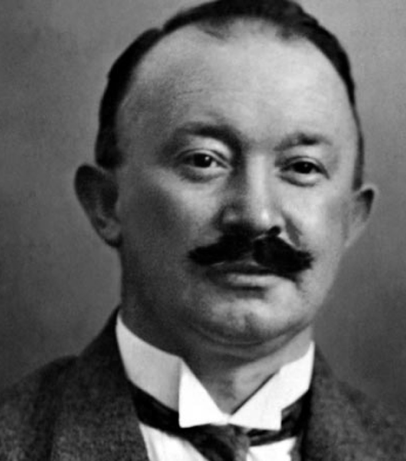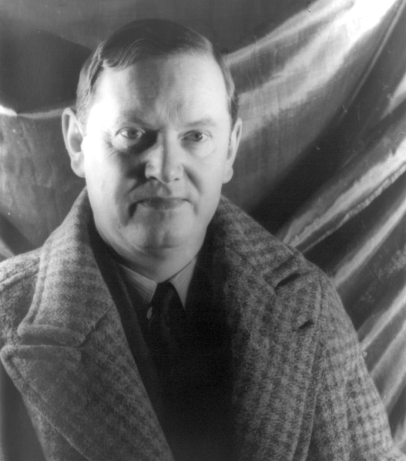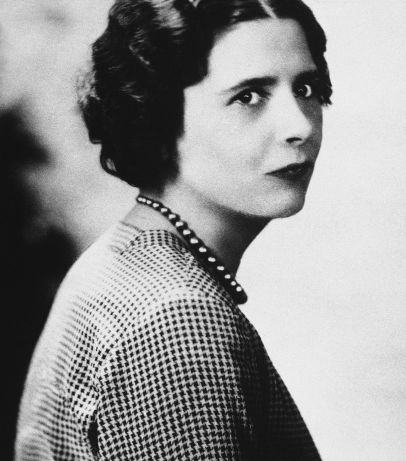Müller was mentioned at the Nuremberg Trials almost as often as Hitler and Himmler. All three would have definitely ended up in the dock had they not been dead. But unlike his superiors, decades later Müller suddenly "came back to life", appeared in police reports and became a hero of folklore – funny and harmless – totally different from the real chief of the Third Reich's secret police.
From Aviation to SS
Heinrich Müller was born on 28 April 1900 in Munich and never left Bavaria until he was 14. He was an only child of his parents and a diligent pupil but his teacher called him a spoiled child.
In 1914 he became an apprentice at an aircraft factory in Munich, and three years later enlisted as a volunteer in the army and received flight training. In April 1918, Heinrich Müller carried out an air raid on Paris by his own initiative for which the 17-year-old was awarded the Iron Cross 1st Class.
Müller retired from active service and joined the Munich police at the end of 1919. He spent ten years catching criminals until in 1929 he was asked to join the political department. His job was secretly to monitor Communists, whom he loathed with every fibre of his being. Neither did he have a soft spot for the Nazis.
All that changed in 1933. With the National Socialists coming to power, the political department of the Munich police was headed by Reinhard Heydrich who as the future head of the Reich Main Security Office (RSHA), Deputy Protector of Bohemia and Moravia, and a main architect of the Holocaust was one of the most sinister figures in the Third Reich. Spotting the clever and efficient investigator, Heydrich took him to Berlin in 1934, along with other Bavarian colleagues. There, Müller automatically became an SS-Untersturmführer (Lieutenant). After another two years, skipping three steps, he was promoted to the rank of SS Obersturmbannführer (Lieutenant-Colonel) and Oberinspektor of Police.
“Your Typical Mid-Ranking Official”
The rapid rise of Müller's career did not please the Bavarian Nazis. In a “strictly confidential political reference”, the head of the Gau Munich–Upper Bavaria wrote: “Oberinspektor Heinrich Müller is not a member of the Party. (...) Only by virtue of his service in the secret state police does he enjoy the honorary right to wear the uniform of the SS Obersturmbannführer”.
Munich party functionaries pointed out that between 1929 and 1933 Müller “fought very hard, partly disregarding the legal provisions, against the Left”. But this, too, earned him no sympathy in the eyes of the party bosses: “With enormous zeal and incredible ambition, if it had been necessary to prosecute the Right, Müller would have done all he could to gain recognition from his superiors. (...) He was clearly not a National Socialist”.
The Party members did not appreciate the upstart Müller's moral character as well. “He is an inconsiderate man, does not tolerate within his circle people who impede his aspirations to advance his career (...) but willingly allows himself to be praised for work he did not do. At the same time, he does not shy away from violating basic notions of camaraderie”, the authors of the letter noted. “There is no reason for Müller's favourable promotion as he has no merit in the national revival”.
The Gau leadership decided to inquire about Müller's career with the local NSDAP group in Pasing to which the target was assigned. The answer did not clarify the situation: “How Müller obtained his honorary title in the SS is unknown to us. (...) We can hardly imagine him as a member of the party”.
But in January 1937, Müller had already leapt three more steps up the hierarchical ladder, becoming Oberregierungsrat (chief government adviser) and Kriminalrat (criminal police adviser), and soon attaining the rank of SS-Standartenführer (Colonel).
He proved to be a born executive. He disliked educated people and once told the head of political foreign intelligence service, Walter Schellenberg, that “intellectuals should be sent to a coal mine and blown up”.
“[Müller] was an archetypal middle-rank official: of limited imagination, non-political, non-ideological. His only fanaticism lay in an inner drive to perfection in his profession and in his duty to the state,” wrote Himmler's biographer Peter Padfield. “A smallish man with piercing eyes and thin lips, he was an able organiser, utterly ruthless, a man who lived for his work.”
Although he was raised in a Catholic family, Müller broke off relations with the Church in 1937 to comply with SS requirements. His devout parents were offended by this step. In 1939, Müller finally joined the NSDAP.
The Gestapo Man
In October 1939, Reichs-Kriminaldirektor Müller became chief of Amt IV (Department IV) of the Reich Security Main Office (Gestapo, the Secret State Police Office), and in November 1941 he was promoted to the rank of SS-Gruppenführer and Generalleutnant der Polizei (lieutenant-general). To distinguish him from another SS general named Heinrich Müller, he was referred to as “Gestapo Müller”.
When he assumed this post, Müller concentrated enormous power in his hands – it was the Gestapo that tracked down and persecuted enemies of the Reich, the Party and the Führer, not only in Germany but also in the occupied territories. It was the Gestapo's professionalism and political indifference that allowed the chief of the secret police to feel superior to those at the top of the Reich. He retained independence even with regard to SS-Reichsfuhrer Heinrich Himmler, the chief of the Nazi Party Chancellery Martin Bormann and his immediate superiors – Heydrich and his successor Ernst Kaltenbrunner.
Heads of neighbouring departments of the RSHA – Walter Schellenberg and Head of the Kriminalpolizei (Criminal Police) Arthur Nebe – noted that Müller was repulsive by his mere appearance: he had his hair parted down in the middle, a shaved back of his head, compressed lips, piercing eyes, constantly trembling eyelids.
The Gestapo chief carried out his duties searching for and eliminating "enemies of the Reich" with zeal, precision and ruthlessness. Among his most famous operations were the liquidation of the pro-Soviet underground organisation “The Red Orchestra”, the search for people involved in the “generals' conspiracy” (an attempted coup d'état on 20 July 1944), and his active involvement in the Holocaust. In October 1944, Müller was awarded the Knight's Cross of the Military Merit, noting the “diverse methods of modern prevention” he had developed in the fight against enemies of the Nazi state.
Wehrmacht General Erwin Lahousen testified at the Nuremberg Trials that Müller insisted on killing Soviet POW officials and Communists and that his only concession was that, out of respect for the sensitivity of the military, executions should not take place in their presence.
‘I Have Zero Intention of Being Captured by the Russians’
The Gestapo chief vanished without trace in May 1945, on the eve of Victory Day. What is certain is that on 28 April 1945 he was interrogating a suspect in the crypt of the bombed-out Trinity Church in the Mauerstraße in Berlin. And the next day, at the time of Hitler's suicide, he was very close to him - in the Führer's bunker.
Witnesses questioned by the West German police in 1961 said that they last saw Müller on the evening of 1 May 1945. According to eyewitnesses, he refused to join a group that attempted to break through the Soviet encirclement during the night. “I know very well the methods of the Russians. I have no intention of being captured by the Russians”, he said, according to Hitler's personal pilot and Müller’s old friend, Hans Baur. Another witness quoted him as saying: “The regime has fallen and so have I”.
In August 1945, a corpse in a general's uniform was found in a makeshift grave in the grounds of the Ministry of Aviation. Inside a pocket was a service card belonging to SS-Gruppenführer Heinrich Müller with his photograph on it. The body was reburied in the old Jewish cemetery on Große Hamburger Straße and then allegedly moved to the Lilienthalstraße garrison cemetery.
In September 1963 the remains buried in Lilienthalstraße were exhumed by order of the public prosecutor's office. Three skeletons and a skull were found in the grave, but the body of the Gruppenführer was not among them.
Panama, CIA, NKVD
This gave rise to numerous conspiracy theories. Müller's colleague and rival Walter Schellenberg stated in a memoir published after his death in 1956 that Müller did not die in 1945 but was recruited by the NKVD and lived in the USSR. Allegedly a German POW, whose name was not given, saw the Gestapo chief in Moscow in 1948 and died shortly after. In 1961, Lieutenant-Colonel Michael Goleniewski, the deputy head of the Polish military counterintelligence service, who defected to the United States, said he had heard from Soviet top brass how between 1950 and 1952 the Soviets “picked up Müller and took him to Moscow”.
Other historians speculated that Müller, like many of Hitler's accomplices, had gone into hiding in South America. In 1967, a man named Francis Willard Keith was detained in Panama. West German diplomats insisted that Panama extradite him for trial. The West German police caught two Israeli operatives trying to break into the Munich apartment of Müller's wife. Sophia Müller identified Francis Willard Keith as her husband. However, fingerprinting showed that it was a different man.
In the Nineties, the books “Gestapo Chief: The 1948 Interrogation of Heinrich Müller” and “DC Diaries” were published in the United States, with Heinrich Müller listed as the author. The Gestapo chief allegedly admitted that he had been recruited by the CIA. According to this theory, he then lived in America and died in California in 1982. But the texts turned out to be a literary hoax.
There was another version that Müller did not leave Germany at all but became an agent of the Stasi, the secret service of the German Democratic Republic (East Germany).
In 2013, Johannes Tuchel, professor of political science at the Freie Universität Berlin and head of the German Resistance Memorial Centre, published new documents: undertaker Walter Lüders, who discovered the corpse in a general's uniform near the Ministry of Aviation in August 1945, told the police in October 1963: “I have compared the picture with the face of the corpse. I can say that the man on the photo just visually matched the corpse”. However, the body was reburied not in Lilienthalstraße, as previously thought, but in the Jewish cemetery in the Mitte district. This is why Müller's remains were not found when the corpses were exhumed in 1963.
‘They Will Tell Legends About Us’
In the meantime, writers savoured the story of the “rescued” Müller. He gained fame in the Soviet Union thanks to Yulian Semyonov, writer of spy fiction and detective fiction, including the famous Stierlitz series. Müller appeared in the second and most famous novel in the series, Seventeen Moments of Spring (1969).
“Hitler brought Germany to disaster (...) Himmler's men abroad were under surveillance, he demanded results from the agents, he did not take care of them,” reasons Semyonov's Müller. “Himmler could not disappear in this world. Bormann could.... The majority of Himmler's money deposits in foreign banks are under surveillance of the Allies. But Bormann has hundred times more money, and no one knows about it.... Himmler's gold is nothing.... But the party's gold – Bormann's gold – is not for lousy agents and converted ministerial drivers, it is for those who, in time, will understand that there is no path to peace except through the ideas of National Socialism.... Those who are now 10 years old do not need us: neither we nor our ideas; they will not forgive us for starvation and bombings. But those who do not know anything now, will tell legends about us, and legends need to be encouraged, we need to create storytellers who will translate our words into a different way that people will understand in 20 years' time. As soon as somewhere someone says 'heil' to someone's ‘hello’, know that we are welcomed there, and that is where we will begin our great renaissance!”
In Seventeen Moments of Spring, Müller does not yet see himself as an activist in the neo-Nazi underground: “The Gestapo Müller is an old, tired man. He wants to live out his years in peace somewhere on a small farm with a blue pool, and for that he is now ready to take some action”.
In the sequel, The Order is to Survive (1982), he plans to use Isayev-Stierlitz by slipping fake dirt on Soviet commanders. The scam fails and the Gestapo chief disappears.
In the novels Expansion-I (1984), Expansion-II (1985) and Expansion-III (1986), Müller was portrayed as a key figure in a network of Nazi agents who set up its work in Latin America. While in the mountains of Argentina, he pulls the strings of world politics, including the development of atomic weapons, in an attempt to preserve the remnants of National Socialism and revive the Third Reich. In the last part of the trilogy Stierlitz, together with an American intelligence agent, kidnaps Müller and transports him by plane to an unknown location – but then the Soviet security agents interfere and arrest Stierlitz himself. Müller's fate remains unknown; he is not mentioned in the rest of the Stierlitz novels.
Bullets Bounced Off Müller One by One. ‘Armour-clad’, Stierlitz Deduced
Filmmakers, too, could not overlook such a striking figure. Perhaps, the very first "Müller" was played by Polish actor Roman Sykala in the Polish television series “Stawka wieksza niz zycie” (“Bet Higher Than Life”, 1967-1968). But Müller's image became widely popular in 1973, thanks to the film “Seventeen Moments of Spring” directed by Tatiana Lioznova and starring Leonid Bronevoy - a stage actor unfamiliar with film acting - as the Gestapo chief.
Bronevoy plays a short, plump, blond man with receding hairline and a good-natured smile, while the real Müller was lean with brown hair and a curved nose. The character played by Bronevoy, despite his accentuated Nazism and his willingness to take out his enemies, is charming, whereas the real Müller was very unpleasant to talk to. American journalist William Shearer, who worked in Nazi Germany, described the secret police chief as a “cold, detached killer”. On-screen Müller is impulsive, he explodes every now and then, in moments of irritation he turns his neck (a gesture invented on the film set because the actor's tight shirt collar made him uncomfortable). However, Wehrmacht Major-General Walter Dornberger described a completely different man: “cold curiosity and extreme restraint”.
This striking dissimilarity was because the writers of the series could not find a photograph of the Gestapo chief. Bronevoy himself later claimed that if he had known Müller's appearance, he probably would have turned down the role.
However, in the public's mind, the character and the actor merged into one. They say that when KGB Chief Yuri Andropov was writing a decree issuing awards to the cast and crew of “Seventeen Moments”, he forgot the actor’s surname and simply wrote: “Müller”.
By Daniil Sidorov
Sources:
‘Gestapo-Müller: A Desk Criminal's career’ by Andreas Seeger
Leonid Parfenov “Seventeen Moments of Spring: Twenty Five Years Later
























